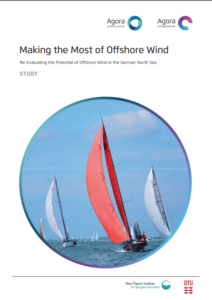Using HPC to model wind farm cluster wake impacts: wind resources in the German Bight
A recent study using mesoscale modelling, as well as a simplified kinetic energy balance model, has indicated the need for international coordination of offshore wind farm planning. The HPCWE project will increase our capacity to perform calculations of this sort, and increase the accuracy of the results.
DTU Wind Energy and MPI-BGC collaborated on a project funded by the german think tanks Agora Energiewende and Agora Verkehrswende to assess scenarios for the German Bight with installed wind capacities between 14 GW and 145 GW. This generously encompassed the range of scenarios from German authorities that range from 50 GW to 70 GW and allowed for exploration of pushing scenarios to huge capacities. The purpose of the study was to determine drop in efficiency of wind farms, when the German Bight becomes increasingly populated with wind turbines.
The full project description and full report can be found here: https://www.agora-energiewende.de/en/publications/making-the-most-of-offshore-wind/
 Mesoscale modelling of the wake impacts of large clusters of wind farms requires HPC to be performed, as the domains of interest are large (c 1000×1000 km), the resolution needed to capture the outline of wind farms is relatively high (2km) and the simulation time period needs to be representative (minimum 1 year). Numerous simulations are required to cover a set of scenarios, and a reference simulation is also needed. In this study 8 simulations covering a 1-year period were performed. Efficient use of powerful HPC resources are demanded if such a study is required in a timely fashion, or needs to be updated, e.g., for a different turbine technology.
Mesoscale modelling of the wake impacts of large clusters of wind farms requires HPC to be performed, as the domains of interest are large (c 1000×1000 km), the resolution needed to capture the outline of wind farms is relatively high (2km) and the simulation time period needs to be representative (minimum 1 year). Numerous simulations are required to cover a set of scenarios, and a reference simulation is also needed. In this study 8 simulations covering a 1-year period were performed. Efficient use of powerful HPC resources are demanded if such a study is required in a timely fashion, or needs to be updated, e.g., for a different turbine technology.
Within HPCWE we are developing better ways to model wind farm wakes within the mesoscale modelling, using a “turbine layout aware” approach. This requires an efficient handling of IO related to accessing look up tables of aggregated wind turbine thrust for different wind directions and wind speeds based on pre-calculated higher resolution modelling. Ensuring good scalability and performance of this modelling approach will allow for rapid assessment of wind farms’ own influence on wind resources. This is an urgent requirement considering there are plans for wind farm clusters in the North Sea, Baltic Sea, South China Sea, off the US east coast, and off Indian southern coasts, amongst others.
